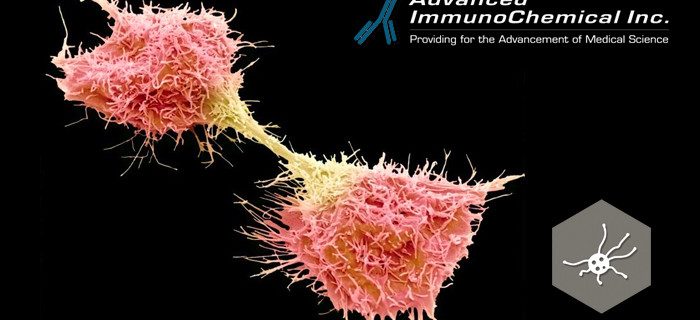Tumor biomarkers play a crucial role in monitoring of response to therapy and in post-treatment surveillance of various gastrointestinal and gynecological malignancies. While the clinical value of FDA-approved tumor markers such as CEA, CA19-9 and CA125 has been established, adequate data to support FDA approval of CA72-4 as a potential biomarker are lacking and its measurement is only considered experimental and investigational.
Available now: monoclonal antibodies and antigens for the detection of tumor biomarkers for pancreatic, ovarian and gastrointestinal cancers from Advanced ImmunoChemical.
CA72-4. The tumor marker CA72-4 was first described by Dr. Jeffrey Schlom in the early 1980s as a novel antigen reactive to murine antibodies produced by mice that were immunized with membrane-enriched fractions of human metastatic mammary carcinoma cells. Several antibodies were identified to have preferential binding to human carcinoma cells with sparing of normal adult tissues.
Despite early studies indicating a possible role of CA72-4 in the monitoring of advanced disease, testing for CA72-4 has not been widely adopted in the United States. Studies conducted on Japanese and East Asian patients with gastrointestinal malignancies combining CA72-4 with CEA and CA19-9 has shown useful disease correlation, with sensitivity of up to 74% without impairing specificity.
Detectable levels of CA72-4 have also been found in patients with tumor of multiple origins including cancer of the lung (36%), ovary (24%, of which more than half had stage IV disease), and colon (40%). Sensitivity of up to 40% in patients with colorectal and gastric carcinomas and 50% in ovarian cancer, with an overall specificity of over 95%, have been reported.
CEA. A 180-kDa oncofetal cell-surface-anchored glycoprotein, CEA was first isolated in 1965 by investigators at McGill University from human colon tissue extracts. The glycoprotein, with a half-life of approximately 7 days, was found to be expressed in gastrointestinal and mucosal tissue during fetal development but only minimally expressed in adult tissue. Further studies showed that it was also overexpressed in adenocarcinomas of varying origin including gastric, hepatic, lung, pancreatic, ovarian and prostate. In colon cancer, the specificity and sensitivity of CEA has been shown to vary with advancing tumor stage, with specificity ranging between 37% and 86% in advanced disease, providing a useful means of monitoring disease. CEA may also be elevated in benign conditions such as inflammatory bowel disease, pancreatitis and in smokers, limiting its utility in early-stage cancer and in patients with such conditions.
CA125. Encoded by the MUC16 gene, CA125 is a member of the mucin family of glycoproteins and is normally expressed in developing fetal epithelial lining of the body cavities and the female reproductive tract. The protein was first discovered by Dr. Robert Bast and other investigators at Harvard Medical School in 1981 after murine monoclonal antibodies were found to have reactivity with human epithelial ovarian carcinoma but not with non-malignant human tissues. CA125 is also associated with malignancies of the endometrium, fallopian tube, breast, lung, esophageal, gastric, hepatic and pancreatic cancers. Elevations in CA125 have also been observed in non-malignant conditions such as during menses, late pregnancy, episodes of serosal irritation such as endometriosis, benign follicular ovarian cysts, and conditions associated with inflammation such as pelvic inflammatory disease, peritonitis, ascites, pericarditis and pleural effusions. CA125 expression has been found to be positive in up to 83% of patients with advanced epithelial ovarian cancer but only in 50% of patients with stage 1 disease, thus limiting its role in ovarian cancer screening in the general population.
CA19-9. CA19-9 has been validated as a serum tumor marker for patients with advanced pancreatic cancer. However, elevations have also been demonstrated in malignancies of the esophagus, stomach, gallbladder, biliary tract, and pancreas. Using 37 U/ml as cut-off for the upper limit of normal, sensitivity and specificity of 81% and 90% respectively have been reported in patients with pancreatic cancer with specificity increasing to almost 100% when a cut-off of 1,000 U/ml was used. Values over 1,000 U/ml also had implications in management and predicting response to therapy. For example, patients with a CA19-9 level greater than 1,000 U/ml at time of diagnosis were more likely to have unresectable disease. Biomarker analysis in large phase 3 pancreatic cancer trials showed that a decrease in CA19-9 by at least 90% correlated with increased survival.
Limitations of CA19-9 include its dependence on fucosyltransferase for synthesis, an enzyme absent in up to 5% of the population, which is also required for human blood group Lewis antigen synthesis. As a result, measuring CA19-9 in patients with Lewis-null blood type may result in a potential false-negative result, further limiting its usefulness.
References:
- Guadagni, F., Roselli, M., et al. Cancer Investigation 1995; 13(2): 227-238.
- Chao-Xu Zheng et al. World J Gastroenterology 2001 Jun 15; 7(3): 431-434.
- Anticancer Research. July 2017 vol. 37 no. 73649-365
Ordering Information:
Cat. #2-CA72. Monoclonal Mouse Anti-CA 72-4
Cat. #8-CA199. CA19-9, human liver carcinoma
Cat. #2-CA19. Monoclonal Mouse Anti-CA 19-9
Cat. #8-CA125. CA125, human adenocarcinoma
Cat. #2-CA125. Monoclonal Mouse Anti-CA 125
See our other Tumor Markers at: www.AdvImmuno.com/shop.
Best regards,
Anne Tolles, M.Sc./President


